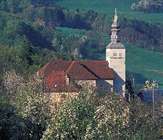Villard village
The first chapel was built in 1302 on the foundations of the current church. The 16th century “Sarde” church was rebuilt in a neo-classical style after the French Revolution. It stands out for its altar piece and dome-shaped bell tower.
In 1774, an oak crucifix was built on the Pointe de Miribel overlooking the village and became a pilgrimage site. Local stoneworker, Joseph Marie Félisaz a.k.a. le Miton from the hamlet of Bourgeau, sculpted 17 blocks of pink limestone on-site to make the cavalry of Miribel in 1804. The annual pilgrimage takes place on the Sunday after August 15th. This artist made the cross in the village centre of Veillaz Derrière in1803, listed as a Monument Historique.
Farm life is still very much in evidence. Milk production is used to make AOC cheeses such as Reblochon and l’abondance. This cheese is made in 4 locations including some on the farm. Cows graze on the mountain pastures in the summer and around the village.
The forest and mountain pastures have pride of place.
Walkers enjoy exploring these landscapes on the footpaths from the main town. You can end your walk at the Miribel viewing table with endless views to the Mont Blanc and the Aravis, the lac Léman, the valley and the Jura.
Villard has had an “Art et Essai” listed cinema called “La Trace” since 1992. It works with several partners including an association of volunteer projectors.
In 1774, an oak crucifix was built on the Pointe de Miribel overlooking the village and became a pilgrimage site. Local stoneworker, Joseph Marie Félisaz a.k.a. le Miton from the hamlet of Bourgeau, sculpted 17 blocks of pink limestone on-site to make the cavalry of Miribel in 1804. The annual pilgrimage takes place on the Sunday after August 15th. This artist made the cross in the village centre of Veillaz Derrière in1803, listed as a Monument Historique.
Farm life is still very much in evidence. Milk production is used to make AOC cheeses such as Reblochon and l’abondance. This cheese is made in 4 locations including some on the farm. Cows graze on the mountain pastures in the summer and around the village.
The forest and mountain pastures have pride of place.
Walkers enjoy exploring these landscapes on the footpaths from the main town. You can end your walk at the Miribel viewing table with endless views to the Mont Blanc and the Aravis, the lac Léman, the valley and the Jura.
Explore – advice, tips
Explore the lakes, many oratories and crucifixes dating back to the 18th century and traditional chalets on the footpaths.Villard has had an “Art et Essai” listed cinema called “La Trace” since 1992. It works with several partners including an association of volunteer projectors.
Contact
Accessibility
Theme:
Share :

